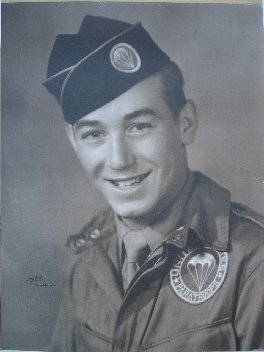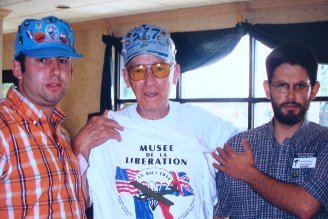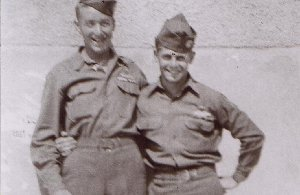Sorry I've been quiet on Mail Call - the school year has started with a bang, but I am so happy the pictures keep pouring in!
It was an honor to be with some of my favorite vets on this trip. Sospel was our first stop, and Roland and Company were waiting for us all at the airport complete with Jeeps! We had a convoy of jeeps and rental cars from the Nice airport up to the winding roads in the Sospel area, about an hour ride.
We checked into our side-by side hotels, and headed up to Patricia and Roland's for lunch. The photos say it best - there were jeeps and tents set up - both vintage army tents and a large tent where we ate meals all weekend long. Food was so incredible that we'd literally take pictures before eating.
There were so many highlights just in Sospel. Patricia and Roland dedicated a memorial on their property, built of the WWII relic equipment and shells that were found on their land. We were treated to a walking tour of Sospel, guided by Patricia's dear friend Isabelle and a gentleman pursuing his doctorate in history who's already written a book on WWII. The history of Sospel goes way back; Sospel was on the Salt Route during medieval times, and the famous bridge (oft-photographed) does as well. Only a mile or two or three from the Italian border, there is an influence that we would think of as Italian, but actually flows from the House of Savoy (which preceeded Italy). Isabelle's tour was superb; she even managed to score the key to the town's cathedral! We were able to have a private tour of that beautiful church, still in use.
Our tour wound up at the Pont de la Liberation - The Bridge of the Liberation. Flowers had been placed and the veterans were received by the mayor and the assistant mayor. Pictures were taken (but the group was so large it was hard to get everyone in!), and we headed off to the hotel, where a most lovely luncheon awaited. Hosted by the Mayor Lorenzi and the Third Assistant Mayor Ferraro, it was a lovely event capped by the presentation of the city's medals (kind of the equivalent, I gather, to the key to the city in the US) to the veterans present: Leo Dean, Hal Beddow, Lud Gibbons, Merle McMorrow, Gene Frice and Allan Johnson, as well as to Nancy Fraser Armand and Tom Copsey, who represented their fathers. Merle was pleased to present the framed certificate of appreciation (drafted by Howard Hensleigh, beautifully executed by Bob Barrett with frames purchased by his wife and actually framed on site by Joanne Barrett - truly a team effort!) in thanks for the friendship of the people of Sospel, as well as to Patricia and Roland. Copies of the Paratrooper's Odyssey were also presented to the town for the library as well as to our guides that day.
We were also able to visit a fort along the Maginal Line, built between the world wars for the defense of the area, and were also able to get to Col de Braus, another important 517 site. The gentleman who owns the small cafe in Col de Braus (population: 2, according to the gentleman, but his wife was gone for the day). This small place has a wall devoted to the history of the 517; our host was wearing an NYPD shirt (no kidding!) and was thrilled to accept the framed certificate to the people of Col de Braus. We even got to the former Golf Hotel (now vacation condos, if I understood our hosts correctly). Pascale and his wife had a lovely tea for us at their home adjacent to the Golf Hotel and we were able to see their small chapel, built to celebrate the safety of the people of Sospel at war's end. A mass is celebrated there every year.
Roland and Patricia were unbelievable hosts; Roland even led us to Le Muy, taking us past the famous area where so many days had been spent rebuilding the road (there are pictures of this in many of the books and on the website; my dad recognized it instantly when we drove that way).
Patricia and Roland coordinated with many officials and so many of their friends to make it stupendous. People literally came in droves, bringing platters of unbelievable food. Personally, this was my first visit to Sospel, and it could not have been more special.
We also ended our time in France with Roland and Patricia in Cannes, but that is a story for another day.
Hugs to all my favorite vets -
Claire
Gilles Guignard
We would like with this mail to request a little room for one of our friend.
We met him for the first time in Columbus 1999 reunion, he came in our home in France in 2000, we drove him in all the battle field, We loved him so much and he treated us as his "french kids" we are so proud that he gave us his jump suit and dog tags exhibited in Le Muy Museum to perpetuate his memory for the future generation.
As a Graphic art designer he designed for the first time the formal baseball cap of the association. He served as scout on 517th."F" company with best friend Gene Frice , since the start of the unit to the end. he jumped in le MUY southern France on the 15th of august 1944, he was wounded on the hill 1098 near col de Braus.
He was a very proud military veteran, he passed away on the 27th of October 2008 , the friendship he made in the 517th have carried over to this day.
This year was a special anniversary in Le Muy we share it with his wife Jeanne, his daughter Melanie and 2 grand daughter Bethanie and Megan.
dear Ben, hope that you will find a little room on your website to remember our loved friend Gary L. DAVIS.
thank you so much in advance.
kind regards,
Your friends
Eric, Mickael & son Adrien
Le MUY airborne Museum France




Yes, I saw Cecil Doty's contribution to the railroad crossing. I think Lud Gibbons probably yelled at him to get down as he did to Freeman. We, the MG/bazooka section, were just to the left of H Co. on the north side of the tracks. I don't know what he means by the overpass and the highway, but that is not uncommon.
I do think you are right about being able to put it all together. The next morning after my H Co. squad patrol, the rifle companies moved out to occupy the rest of the objective we had rendered safe by the patrol. We took the German platoon prisoners they would have faced in defensive positions with good fields of fire over open terrain up on the high ground. As they moved out to complete taking the 3rd Bn. objective, G or I company was undoubtedly on H Co's. left and the other company in reserve. My guess is that they went through until they reached the north-south highway (was it D66 on your map?) which must have been the western limit of 3rd Bn's. objective.
Apparently Bill Boyle and his men were trapped somewhere in the built up part of Les Arcs. The 1st and 2nd Bns. had been doing their best to achieve the Combat Team's objectives while we were on the forced march back to the drop sone. To relieve the pressure on 1st Bn., Second Bn.'s attack sector was undoubtedly bounded on the south by the railroad and we, at first, were to attack the next morning and clear everything south of the tracks. Then when Graves learned that Mel Zais had a fairly well organized Bn., they decided to attack at once to secure the area for the 517th and for the seaborne troops coming from the beach. It demonstrates good timing and good leadership at the top.
My next order was to take my MG/bazooka section to set up a road block down south on the highway to keep the enemy from returning. Instead, we greeted motorized units of the seaborne invaders after some time, probably the next afternoon. Our road block was near a house on the east side of the road. In it lived a Frenchman who had married a German. She helped us with our rations and added a lot on her own to make it a feast for the hungry section men, including me. It was not long before several FFI men showed up to haul her off for being German and for being friendly with the German troops while they were there. I told them to hit the road and that when civil authority was established with a court system, they could bring charges. I must have sounded like I knew what I was talking about because they left without the lady. It is quite possible that this lady had helped feed the German soldiers as she had us, because behind the house and to the east there had been a German mortar crew set up and operating in an orchard. All that was left of them were the mortar totally destroyed and body parts of the crew hanging from the fruit trees. The crew had taken a direct hit from one of the 442nd 4.2 mortar rounds. I'm not sure they knew exactly what they were aiming to hit, but if it was the enemy crew they were accurate.
One of our Kansas men, and it could have been Cecil, worked for a public utility. On one of his calls he noticed a 517th emblem on the desk of the man he was calling on. When asked how he got it the older gentleman said his son was in that outfit but was killed in France. It was Sgt. Gaunce's father. I think I have these facts straight but they are all from memory.
Your tenacity has helped us unearth many facts about the first few days in S. France.
Our thanks for your interest. Howard Hensleigh
JERRY WOLFFORD
"Geronimo"
|